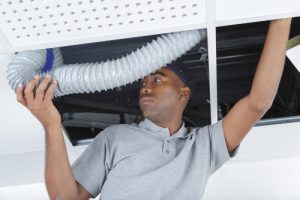 Central air conditioners circulate cooled air via a system that includes supply and return ducts. The air conditioner cools the air and sends it to the house through supply ducts or registers. The cooled air circulates throughout the house, becoming warmer. It then flows back to central air conditioners through return registers and ducts.
Central air conditioners circulate cooled air via a system that includes supply and return ducts. The air conditioner cools the air and sends it to the house through supply ducts or registers. The cooled air circulates throughout the house, becoming warmer. It then flows back to central air conditioners through return registers and ducts.
Air conditioners improve comfort by dehumidifying the air. In humid climates or when the outdoor temperature is moderate, air conditioners may not be able to reach the desired humidity level. In these cases, homeowners can reduce the thermostat or use a humidifier. In both cases, this will result in increased energy consumption for both the dehumidifier and the air conditioner
Set the fan on “auto” if you have central air in your home. Use circulating fans to circulate air in each room instead of the central fan.
Central Air Conditioners Types
Central air conditioners are either split-system units or packaged units.
In a central split-system air conditioner, the outdoor cabinet houses the heat exchangers, fans, and compressors, while the indoor cabinet contains both the heat exchangers and the blowers. In split-system central air conditioners the indoor cabinet can contain a furnace, or the heat exchanger for a heat pump. Split-system air conditioners are the most cost-effective central air conditioners to install if your home has an existing furnace, but no air conditioner.
A packaged central air conditioner consists of a cabinet that houses the compressor, blower, fan and heat exchangers. This cabinet is usually placed on the roof or a slab of concrete next to the foundation. This type of air conditioning is also used in small commercial building. The return and supply ducts are connected to the packaged air conditioner by passing through the exterior wall or roof of the home. Packaged air conditioners may include an electric heating coil or a gas furnace. The combination of an air conditioner and a central heater eliminates the requirement for a separate heating system.
Installing and Locating Air Conditioners
 Your air conditioner should last for many years if it is installed correctly or if any major problems with the installation are identified and corrected. Only minor maintenance will be required. Many air conditioners, however, are not correctly installed. Unfortunately, this can lead to modern energy-efficient models performing almost as badly as older inefficient ones.
Your air conditioner should last for many years if it is installed correctly or if any major problems with the installation are identified and corrected. Only minor maintenance will be required. Many air conditioners, however, are not correctly installed. Unfortunately, this can lead to modern energy-efficient models performing almost as badly as older inefficient ones.
- Be sure to check that the contractor you hire is qualified and experienced.
- Provides enough indoor space to install, maintain, and repair the new system
- Uses a duct sizing method such as that of the Air Conditioning Contractors of America Manual D
- Make sure there are enough registers for the supply of cool air, and enough registers for returning warm air from your home to the air conditioner.
- If possible, install ductwork in the conditioned area, and not the attic.
- Seals ducts and insulates them heavily with duct mastic
- Locate the condenser unit so that its noise won’t keep you or your neighbors awake at night.
- Condenser unit should be located where there are no objects that will block the airflow.
- Verify that the air conditioner is installed with the exact refrigerant and airflow rates specified by the manufacturer
- Place the thermostat far from heat sources such as windows and supply registers.
Choose or Upgrade Your Central Air Conditioner
Air conditioners in the room are less efficient. They are also out of the way and quiet. You can save money and energy by buying an energy-efficient central air conditioner. Air conditioning in a typical home consumes over 2,000 kilowatt hours of electricity each year. This causes power plants to emit 3,500 pounds carbon dioxide and about 31 pounds sulfur dioxide.
Ductwork may be a deciding factor when adding central air conditioners to your home.
Most efficient air conditioners require 30% to 50% less power to achieve the same cooling capacity as older air conditioners from the 1970s. You can save up to 40% on cooling costs if you replace your old air conditioner with a more energy-efficient model, even if it is only 10 year old.
The efficiency of an air conditioner is determined by the size and installation. A unit that is too large will not be able to remove the humidity effectively. A unit that is too small will be unable to maintain a comfortable temperature during the hottest of days. Inefficient ducts, improper installation, or a unit that is not properly positioned can reduce efficiency.
Look for an air conditioner with high efficiency when buying one. The seasonal energy efficiency rating (SEER) is used to rate central air conditioners. The SEER rating indicates the amount of energy required to achieve a certain cooling output. Many of the newer systems can have SEER ratings up to 26.
Consider replacing your old air conditioner with an energy-efficient one. You can find central units that are 15% more energy efficient by looking for the ENERGY STAR (r) or EnergyGuide labels. The new residential central air conditioning standards came into effect on Jan 1, 2015. For more information, see the efficiency standards of central air conditioners. Consider purchasing a system that has a higher SEER rating than the minimum to save money.
Standard requirements do not mandate that you replace your central air conditioners. Replacement parts and services are still available for the systems in your home. A central air conditioner has a “lifespan” between 15 and 20 years. After the new standard is implemented, manufacturers will continue to support their existing equipment. They’ll provide replacement parts and honor maintenance contracts.
When buying an air conditioner, you should also consider:
- Air conditioning systems with variable speeds
- Quiet operation is possible with this unit
- Filter check light reminds you to check your filter after a certain number of hours.
- A fan-delay switch that will turn the fan off a few moments after the compressor has shut down.
Before making any decisions regarding your air conditioning, call J.C.’s Heating and Air for a free evaluation of your current system.
J.C.’s Heating and Air
3110 Henson Rd
Suite 7
Knoxville, TN 37921
(865) 388-1712
https://jcsheatingandair.com/
Areas Served: Corryton, Fountain City, Halls Crossroads, Farragut, Powell, Knoxville, Knox County, Oak Ridge, Lenoir City
